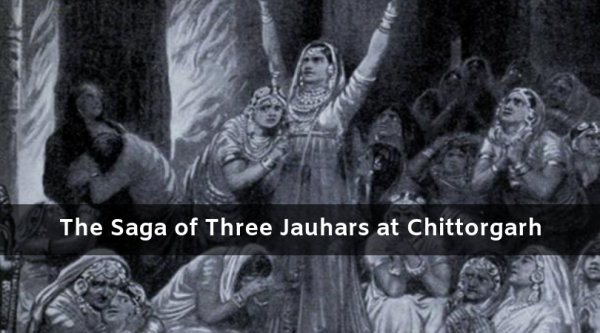Many people are aware of the saga of mass suicide, traditionally known as Jauhar, during Rani Padmini’s time. But apart from that, two more Jauhar took place at the previous capital of Mewar, Chittorgarh.

Jauhar – The Custom of Mass self-immolation
Jauhar which is also pronounced as Jowhar or Juhar was a Hindu custom of mass self-immolation (by burning themselves in the fire) of women and children in parts of Indian subcontinent. This custom was followed in order to avoid capture, enslavement and rape by the invaders when they are facing certain defeat during the war. Even dead bodies were not spared by these invaders whose necrophilic tendencies are recorded in history. The most famous Jauhars of the history was recorded during wars between Hindu Rajput kingdoms in Rajasthan and the Muslim armies.

It has been recorded that the Jauhar and shaakh were never carried out when the Rajputs were at war with other Hindus, such as the Marathas, as the defeated was expected to be treated with dignity.
First Jauhar in Chittorgarh by Allaudin Khilji in 1303
The first Jauhar of Chittorgarh is the most popular one. It was during the reign of Alauddin Khilji when Mewar was ruled by Rawal Ratan Singh. Alauddin Khilji had heard a lot about Zawar, Dariba and Agucha. In fact, mining of zinc, silver and other precious metals in these places were the talk of the nearby areas and far off places. Khilji himself had heard about the mines and so, on 28th January 1303, Alauddin started his March to Chittor with his large army so that he could grab the rich mines.
But on reaching Chittor, he found the Chittorgarh fort to be heavily defended and well-fortified. The Delhi Sultanate arrived at the gate and demanded the Rajputs to surrender. The angry Rawal Ratan Singh refused to surrender even though he knew that his army was too small in front of that of Khilji. This lead Alauddin to surround the fort from all the sides and conduct a siege. He set up a camp between the Berach and Gambhiri rivers.

This siege went on for nearly 8 months which suggests that the defenders put up a strong resistance. Amir Khusrau has mentioned about this siege in his Khaza’in ul-Futuh where Khusrau implies that the frontal attacks by the invaders failed twice. Alauddin also ordered the fort to be pelted with stones from siege engines (munjaniqs), while his armored soldiers attacked it from all sides. The fort might have suffered from a famine or an epidemic.
The long drawn siege gradually depleted all the supplies within the fort. Finally, King Rawal Ratan Singh gave the orders that the gates would open and the Rajputs will fight till death with the besieging troops. On hearing the decision, the women of Chittor had two options either to commit the mass immolation Jauhar or to face dishonor at the hands of the enemy.

The decision was in the favor of the divine suicide Jauhar. A huge pyre was lit and all the women jumped into the flames following their queen. Each soldier got dressed in the Kesari robes and turbans and exchanged paan amongst themselves and marched towards the enemy to fight till death. This tradition is called Shaakh.

According to Amir Khusrau, 30,000 Hindus were “cut down like dry grass” in that war.
However, there’s another story that revolves around this Jauhar. This story is based on the epic fictionalized poem, Padmavat written by Malik Muhammad Jayasi in 1540 CE. According to this poem, Rani Padmavati, also called as Rani Padmini, was the second wife of Rawal Ratan Singh after Rani Nagmati. Alauddin Khilji wanted Rani Padmini to be his’ and so he deceitfully captured Rawal Ratan Singh. Padmavati asks Gora and Badal to help rescue him. They successfully did so but during the fight, Gora was killed.

During Ratansen’s absence, the ruler of Kumbhalner, Devpal proposes marriage to Padmavati which angers Rawal Ratan Singh and he ensures single combat in which Ratansen and Devpal kill each other. Nagmati and Padmavati commit suicide on Ratansen’s pyre. Alauddin’s army reaches Chittor, when the women commit Jauhar and the men fight till death. Alauddin captures an empty fortress, thus denied victory. The victorious Alauddin considers his victory as Pyrrhic.
The sacrifice of these women is not forgotten even today. To commemorate this sacrifice, Jauhar Mela is celebrated in Chittor every year.
You may also want to read – Fairs and Festivals of Chittorgarh
Second Jauhar of Rani Karnavati in 1534
It was Rani Karnavati who hailed from Bundi. She was married to Rana Sangram Singh who was also known as Rana Sanga of the Sisodia dynasty of Chittorgarh. The couple had two sons namely Vikramjit and Udai Singh.
Rana Sangram quickly started to expand his territory. This expansion brought him in direct conflict with the Lodhi dynasty of Delhi. In the year 1518, Rana Sanga destroyed the Lodhi army of Delhi Sultanate. Rana Sanga was wounded in the battle. He lost an arm by a cut of sword and an arrow which made him lame for life. He was already blind from one eye before his coronation. But it did not shake his courage for taking part in the further battles.

Later in the year 1527, during a fierce battle in Khanua between Rana Sanga and the first Mughal emperor Babur, who had captured the throne in Delhi, Rana Sanga died of his wounds. Rani Karnavati was left as a widow and regent of Chittorgarh in the name of her elder son Vikramjit.
Qutub-ud-din Bahadur Shah, Sultan of Gujarat, sensed the opportunity and attacked the Mewar kingdom with his huge army. Rani Karnavati appealed to other Rajput rulers to help them save the honor of Chittorgarh. Meanwhile, the rulers advised Rani Karnavati to send both the princes Vikramjit and Udai Singh to Bundi for their safety.

The Rajputs were prepared to fight till death with the sieging troops all dressed up in Kesariya clothes and turbans and exchanged paan with each other as a sign of parting. Rani Karnavati knew that with such unequal struggle, the Rajput army would surely perish. So she chose the way of Jauhar where women of Chittor led by Rani Karnavati jumped in the pyre of flames.
Whereas Karnavati’s maid, Panna Dhai escaped with both the princes to safety.
Third Jauhar of Chittorgarh
The third destruction at Chittorgarh was done by Abu’l-Fath Jalal-ud-din Muhammad Akbar or simply ‘Akbar’. In the spring of 1568 CE, he wanted to conquer Mewar which was being ruled by the 53rd ruler of Mewar dynasty and the fourth son of Rani Karnavati and Rana Sanga, Rana Uday Singh.
Shyamaldas Dhadhavadhia was a 19th-century writer who has documented the history and culture of Rajasthan. According to an account by him, Udai Singh called a council of war where he discussed the possible invasion of Akbar. These nobles advised him to take refuge in the hills of Udaipur along with his princes.

On the advice of his council of advisors, Rana Uday Singh left the fort to camp in the vast plains of Udaipur. Two brave army chieftains Jaimal and Patta were left behind to defend the fort along with 8000 Rajput warriors. On the other hand, Akbar laid siege on the fortress.
The Rajput army fought heroically. During this situation, Akbar even vowed to visit the shrine of Sufi saint Khwaja at Ajmer to pray for divine help for achieving victory. Jaimal and Fatta Sisodiya estimated the incapability of victory the next day so he ordered Jauhar and on the night of February 22, approximately 8000 women burned themselves down to prevent themselves from slavery.

Next day, the gates were opened and all the Rajput soldiers dressed up in saffron robes exchanged betel leaves and charged out bravely to fight the enemies committing Shaakh. Akbar was furious that the siege took so long and ordered the slaughter of more than 40,000 unarmed old men, women, and children of Chittorgarh.

The sacrifice of these rajputinis, their valor, their strength, and their bravery is still sung in the traditional songs which glorify their act. The need to know the history is not to spread hate but in fact to appreciate the sacrifice and learn from it so that in today’s generation we strive to stop making the mistakes in the name of religion, race, color, caste, etc.
Did you like the article or have feedback about the same? Then mention it in the comment section below or write to me at juhee@udaipurblog.com.
References: Wikipedia, Myindiamyglory, Hindujagruti, Wikimedia Commons


